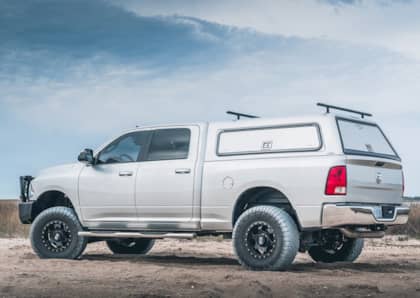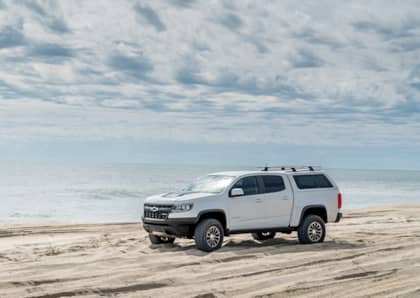Why Average Truck Bed Lengths Are Shorter Now And What That Means For Pickup Owners
Even casual pickup fans have likely noticed that the length of the average truck bed seems to be getting shorter and shorter, even as the overall size of these vehicles continues to increase. It’s not your imagination—most trucks sold today feature cargo areas that are not quite as long as those from 30 years ago.

The reasons why truck beds seem to have shrunk are actually tied to what pickup models have become the most popular, which is in turn linked to how drivers are actually using their vehicles.

Automakers aren’t blind to this shift, which has led to a minor industry of accessories intended to help bridge the gap between perception and reality when it comes to actually doing truck stuff with a smaller cargo area.

That being said, for the most popular pickups out there you can still snag a longer, more useful box if that’s what you’re really after. Just be prepared to make some sacrifices to get it.
The Goldilocks Problem
Traditionally, truck manufacturers have divided up their available bed lengths into three categories: short, regular, and long. There have occasionally been outliers in terms of the overall size of the beds—GM sold an ultra-long 10-foot bed in the 1970s, and of course “flareside” beds cut the horizontal measure down in order to add style to the mix on models like the Ford Lightning—but generally, that trio of bed sizes have held firm for decades.

Although the exact measurements vary, full-size short bed pickups offer around 5’ 6” of length, with regular beds hovering around the 6’ 5” measure. Long beds top out at roughly 8 feet. It’s not unusual to see six foot, or six-and-a-half foot beds from some brands in the mushy middle. These cover popular light-duty choices like the Ford F-150, the Chevrolet Silverado, and the Toyota Tundra, while heavy-duty models like the Ram 2500 and the Sierra 2500 HD tend to drop the short bed from the order sheet entirely.

Moving down to the mid-size segment narrows your choices. Some models, like the Chevrolet Colorado and GMC Canyon, have recently moved to offering five-foot short beds across the board, while the Honda Ridgeline stretches out to 5’ 3” as its only option. The Nissan Frontier provides the choice of beds measuring either just under 5 feet or just over 6 feet, which is similar to what the Toyota Tacoma has to offer.

Finally, more recent compact trucks like the Hyundai Santa Cruz (4 feet) and the Ford Maverick (4.5 feet) deliver the shortest possible cargo carriers on the pickup market. These are matched by the mid-size Rivian R1T electric truck, which also provides 4.5 feet of bed length.
Beds Are The Same, Buyers Are Not
It’s important to understand one key fact when discussing truck bed lengths: in the full-size world, the actual size of current truck beds isn’t all that different than what it’s been since the 1950s. Back then you could get long and short bed options, too, and they were generally within spitting distance of what’s out there now.

In terms of average length, however, there’s been a radical change, and it all boils down to one single factor. Simply put, the popularity of four-door, crew cab pickups has put regular and extended beds on the endangered species list.

The Maverick and the Santa Cruz are perfect examples of the impact of this preference. Each is available exclusively in four-door form, and given the relatively modest size of their platforms, their large passenger compartments limit the physical dimensions of the bed out back. This same principle carries over to the Chevrolet Colorado and the Honda Ridgeline, which also make a crew cab setup standard equipment.

Once you get to the realm of full-size trucks, regular and long beds are in theory more available to shoppers. Heavy duty trucks, for example, often combine long beds with four-door body styles, while light duty trucks can attach them to single cab setups available in lower trim levels. In each of these situations, buyers are typically focused on the hauling side of the pickup equation, and maximizing bed space is more important than how awkward a longer truck can be from behind the wheel.
Crew Cabs Call The Shots
Those two use cases, however, are on the outside looking in when examining the beating heart of the full-size pickup market, which is light-duty crew cabs. These vehicles are almost always offered with the choice between short and regular beds, but most buyers choose the former in order to keep their trucks from feeling too unwieldy in traffic, or when trying to park. You can forget long beds entirely, as they’ve been wiped clean from light-duty crew cabs across the board.

The dominance of light-duty crew cabs are the primary reason why average bed lengths are shorter than ever. A huge percentage of truck buyers aren’t interested in regularly hauling the stereotypical 4’ x 8’ sheet of plywood that once defined the utility of a pickup’s cargo area. Instead, they are using these trucks as commuters, off-road machines, towing rigs, or camping platforms, essentially making them “lifestyle” buys rather than day-to-day workhorses.

This is even more obvious when looking at compact and mid-size trucks, which as mentioned earlier are often sold exclusively in four-door, short-bed configurations, further tilting the average towards the shorter side of the spectrum. It’s simpler far easier to drive a shorter truck, and with most of the platform taken up by the cab, the bed is what sees the scalpel to keep overall length manageable.

In recognition of the shifting usage patterns and preferences of truck buyers, manufacturers have come up with a barrage of accessories like bed extenders, in-bed storage, and even stackers that sit on top of bed rails to double-up on the amount of storage available. Hitch-mounted carriers are another common solution for those who don’t want to hang the wheel of their mountain bike over the top of their tailgate.
No Changes On The Horizon
Truck builders are always going to meet customers where they are. The surging popularity of pickups as daily drivers has caused the entire industry to shift its focus and satisfy the preferences of compact, mid-size, and light-duty full-size customers, which has had the knock-on effect of making long beds a thing of the past for the vast majority of these models.

Long bed trucks will always live on in the heavy duty and commercial segments, but they’re unlikely to make a return for the average buyer as long as pickups continue to be conveyances rather than task-focused machines. For those who truly need an eight-foot bed, and also want to take the entire family along with you, your options are likely to be limited for the foreseeable future. That being said, you could always hook up a utility trailer to tackler oversized jobs—or dive into the accessories catalog for a rack, extender, or stacker solution that works for you.
More From Driving Line
- Road Test Review: The 2023 Ford F-250 Super Duty “Mini-Zilla” V8 Is A Towing Terror
- Real World Tested: The 2023 Ford F-150 Lightning Boosts Beyond Traditional Trucks As The First All-Electric Full-Size Pickup
- Test Drive Review: The 2022 Chevrolet Silverado ZR2 Finds Off-Road Monster Truck Middle Ground In Battle Against TRX and Raptor
- Review: The 2022 Ford Maverick Lariat 2.0T AWD Strikes A Pickup Truck Bargain You Can Live With
- Review: Is The 2022 Honda Ridgeline Still 'Enough' Truck In The Age Of The Ford Maverick?
- Review: Is The 2022 Hyundai Santa Cruz A Legitimate Compact Pickup Contender Or A Crossover In Disguise?
- Review: The 2022 Nissan Frontier Pickup's Long-Awaited Update Is Finally Here, But Does The Truck Go Far Enough?
- Road Test Review: 2023 Chevrolet Colorado Trail Boss Aims At Affordable Off-Roading And Overlanding
- Review: The 2021 Chevrolet Silverado 1500 Duramax Diesel Provides Maximum Torque And Fuel Mileage But Can't Match Refined Rivals











